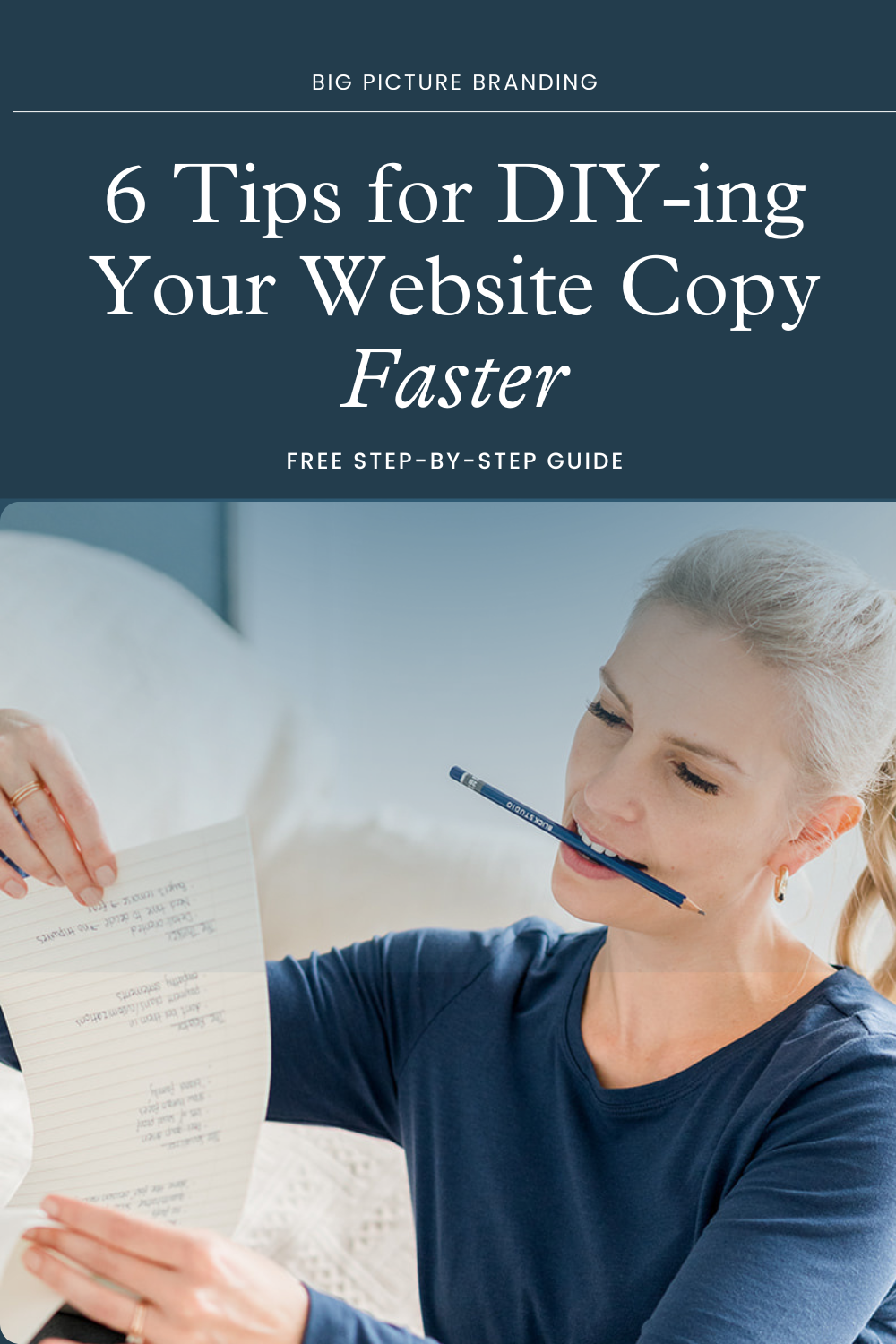When you don’t have the budget to hire a professional copywriter DIY-ing your website copy is the next option. Writing your own copy is a monumental task, but it’s 100% doable if you have a plan.
Following a step-by-step copywriting roadmap will ensure you’re doing things in the right order and set you up for success so you don’t hit writer’s block (the party-crasher caused by a lack of preparation and clarity.)
If you’re looking to DIY your website copy and don’t know where to start, grab the complete roundup of all the resources and templates you can use to write your copy from start to finish. Plus, learn six tips for DIY-ing your website copy faster, with a free step-by-step copywriting roadmap.
>> Grab The DIY Copywriting Roadmap by scrolling to the bottom of this post.
~Pin to Save for Later~

A Professional Copywriter’s Tips for DIY-ing Your Website Copy Faster And More Efficiently
1) Copy dictates design ALWAYS.
Copy and design need to work in beautiful harmony, but the messaging comes first. Close out your website template and open up a Google doc. The risk of writing your copy to fit a pre-designed website is you will inevitably break the design or struggle to try and fit a square peg into a round hole.
It sounds a lot like this: Oh, shoot, I don’t have enough space to say that…my gut/my copywriting tutorial tells me I should talk about offer benefits next, but there isn’t a section for that in my website template…I guess I leave it out…is that really the best strategy? I thought this template looked beautiful, but I’m too constrained to write what I need to write to make a compelling sales case…
Let me answer a few more frequently asked questions about Copy meets Design:
How long should your copy be?
As long as it needs to be.
Which sections should you include on any given page?
That depends on the page goal, the user’s/customer’s level of awareness (how much context and education are needed to prepare someone for the ask/sale), and the desired user experience. If someone tries to convince you their template design is all you need and some level of customization won’t be necessary, run. They are trying to sell you a product, not a solution.
Am I in trouble if I bought a website template?
Not at all! A template is a starting point. As long as you can customize and edit the template easily, a website template is a cost-efficient solution. If it’s in your budget, I highly recommend finding a designer who offers template styling (often a VIP Day offer) to help you apply your copy and brand styling and tweak any wonky sections you DIYd yourself (like when you had to duplicate a content canvas to add a new featured area.) My biggest beef with website templates is they never include enough space for copy or enough content sections. I don’t write a headline aiming for a particular character count to fit the design and neither should you. You can tweak those issues down the line if it makes practical sense, but only AFTER you’ve written your entire page of copy and installed it into your template.
2) Figure out your brand strategy and messaging points first.
Let’s say you’re planning a dinner party for some friends. You would never start by driving to the grocery store and impulsively buying whatever caught your fancy. You’d sit down and ask yourself:
- What’s the dinner party vibe I’m going for? Refined and classy with multiple forks, candles, and a prosecco toast? Or rowdy and adventurous with a make-your-own taco bar, sombreros, and tequila toast that may or may not happen on top of the table?
- Why am I doing this? Why is it worth it to RSVP yes?
- What do I want them to walk away with? (Physical doggy bags? An evening of good conversation? New connections?)
- What ingredients do I need to pull this all together?
- What’s the timing of everything? What’s your dinner guest user flow or funnel? Do they arrive for drinks and canapés before moving into the dining room? Will dessert happen in the living room? When it’s time for your guests to ahem, leave, how will you help them make that decision?
Analogy aside, this is the prep work you need to do before putting the proverbial pen to paper. Not sitting down to work out what your brand is all about, develop your brand messaging points and audience personas and gather your research puts you at major risk of getting “stuck” or cursing the flashing cursor.
I tell my clients that by the time we’ve developed their Brand Strategy Blueprint, their copy is 90% written. The rest is elaboration, organization, and refinement.
3) Develop your offer stack and gather all those details next.
It’s next to impossible to write compelling copy with the goal of selling your services or products if you don’t know what those offers entail. Outlining your services is something we spend a lot of time thinking about in the Copywriting Cohort + Mastermind because now that we’ve gone three levels deep into what your audience actually wants and needs to hear, writing out the deliverables (what people walk away with) and value props can shine a light on an insufficient offer. You might realize you need to alter the deliverables, your process, your timeline, how customized it can get, or whether you need to pivot your offer entirely. In addition to validating your offers, writing out the nitty-gritty speeds up the copywriting process.
You should be able to answer the following before picking up the pen:
- Offer Name:
- Offer Price:
- List of deliverables:
- Who is a fit for this offer?:
- In your ideal client’s words, what problem do they have that this offer solves?
- How does this problem make them feel?
- How would they feel after working with you?
- Why do they care? What will happen if they don’t find a solution?:
- What are some common concerns or questions they’ll probably have about this offer?
- What’s the first step they need to take to get started?
- What’s the high-level process look like? (Example: Kickoff session, Presentation Day, Feedback Rounds, Delivery Day, 30-Day Check-In)
4) Ward off imposter syndrome by writing your Services pages, first.
The reason you should consider writing your services page(s) first is they are singularly focused (you’re talking about one thing and one thing only), you already have half the page figured out (see above) and there’s less pressure to be clever/interesting/ear-catching. You want to keep your reader’s attention, but the focus is really on giving the people what they want (the details) and guiding them to make a decision that’s best for them.
5) Figure out when your distraction-free deep work rhythms happen and commit to writing during those times.
Hello, mother of two tiny mini-humans, who are always homesick, speaking. To say my brain is buzzing with to-dos is an understatement. Finding the time and space to clear your mind drama isn’t always in your control, but that’s why knowing your “on hours” (those times when your biorhythms tend to sink into deep work easily) is key. I’m a notorious night owl (that’s what 20 years in the performing arts/theater world will do to you) and I get a gust of energy at 4 pm and around 10 pm. Buuuuuuut, that all changed when I had kids. I’ve realized that my most productive hours are after I drop my kids off at school, between 8:30 am – and 12 pm. My afternoons are reserved for admin, meetings, and if the muse is hot (or the deadline) more writing. It’s not perfect, but pay attention to your rhythms and make a plan you can commit to for 3-6 weeks.
6) Expect the process to take between three to six weeks (minimum).
Yep! There are no shortcuts, only efficiencies. Take the process in stages (Brand Strategy, Copywriting, Installation & Optimization) and aim to tackle one page a week.
Here’s how things are broken down for my Copywriting Cohort students:
Week 1 – Prep Like A Pro
Week 2 – Prep Like A Pro
Week 3 – Brand Clarity (Brand Messaging & Personas)
Week 4 – Services That Sell (Services Pages)
Week 5 – A Brand Story That Connects (About Page)
Week 6 – Perfect Your First Impression (Homepage)
30-Day Check-In – Ancillary Pages (Contact Page) and Copy Installation
For a complete outline of the tutorials and templates you can use to DIY your website copy…
Download The DIY Copywriting Roadmap ⤵

If you found this article helpful…
The BP Resource Library started as a way to offer brand strategy and copywriting education to creatives and entrepreneurs with champagne tastes but a Pellegrino budget.
If I’m helping you make more sense of this whole “writing for your biz” thing, please consider expressing your appreciation for the research, writing, and design that goes into each and every post and library freebie.
Buy me an espresso
